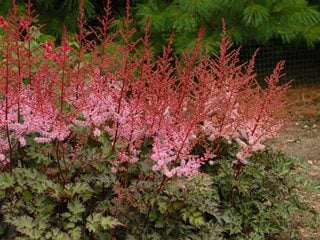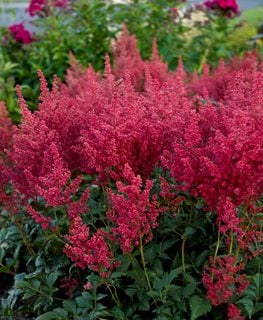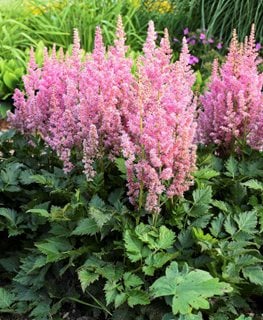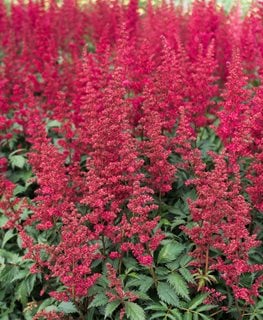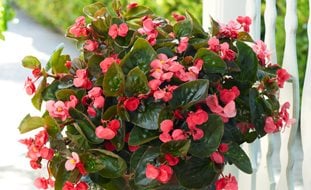Astilbes for All Seasons
By growing astilbe plants with different bloom times, you can enjoy these shade-loving perennials from spring into fall.Move over, ferns and hostas. Astilbe is the new must-have plant for shady garden plots, adding color, height and texture that breaks up the boredom of one-dimensional groundcovers and mounded plants.
“Astilbes are wonderful, virtually indispensable garden perennials,” says garden essayist Allen Lacy, in his book The Gardener's Eye, commenting on how their “steeples and spikes” impart the vertical pizazz needed in every garden.
With hundreds of cultivars available, they also give gardeners a wide range of options in height and bloom time; from the early-blooming 'Rheinland', which opens its fluffy cotton-candy pink spires along with bleeding hearts in May, to the dwarf Chinese astilbe, which blooms in late summer with lovely lilac plumes. “There is so much variation among astilbes that I can conceive of a pleasing garden consisting of few perennials other than hostas and astilbes,” Lacy remarks.
On this page: Basics | Planting | Care | Varieties | Companion Plants
On this page:
BASICS
Common names:
False goat's beard, false spirea, florist’s spirea
Plant type:
An herbaceous perennial that spreads via underground rhizomes.
Zones:
3-9 depending on variety
Exposure:
Best in partial shade to shade
Bloom time:
Astilbes are typically classified as early, mid, or late season bloomers, depending on the species and cultivar. Early blooming varieties emerge in spring, while late bloomers hold off until July or August. Because the bloom times vary widely, you can combine plants from each category for an ever-blooming garden from May through September.
Length of bloom:
4 to 6 weeks
Height:
8 inches to 4 feet
Characteristics:
Astilbes provide year-round interest, beginning with their foliage in early spring and ending with dried feathery plumes and seedheads in winter. In between, these showy perennials are some of the best plants for summer color, displaying delicately fragrant bottlebrush-shaped blooms in colors ranging from creamy white and soft pink to deep purple and crimson red. Astilbe flower clusters range in size from 6 inches to 2 feet in length, depending on the species or cultivar.
Even when not in bloom, their fern-like foliage remains attractive all season and are often enhanced by tones of bronze or burgundy. Some have especially eye-catching foliage in shades such as bright chartreuse, chocolate, and russet red.
Common types:
Hybrid astilbe (Astilbe ×arendsii): This is by far the largest group of garden hybrids and includes more than a hundred varieties. Most are early-season bloomers, emerging in late spring or early summer.
- Chinese astilbe (Astilbe chinensis): These fast-spreading, rhizomatous plants are often used as groundcovers. They bloom later than the arendsii hybrids and are more drought and heat tolerant.
- Japanese astilbe (Astilbe japonica): An early-to-mid summer bloomer with dense, pyramidal flower plumes.
- Star astilbe (Astilbe simplicifolia): A slow-growing, compact plant with shiny leaves and delicate starlike flowers. Like A. chinensis, it blooms late in the season.
PLANTING ASTILBE
When to plant:
In spring after the threat of severe frost has passed, or in early-to-mid fall.
Where to plant:
Grow astilbes in partial shade to shade, tolerating filtered sun. However, they will grow well in full sun in northern zones. “Their best use, however, may be in light shade, since they provide a bright splash of color to banish gloom.” In warm southern regions, plant astilbes in partial to full shade to prevent scorching of the leaves.
Soil:
All astilbes, even the more drought-tolerant varieties, prefer cool, moist soil rich in organic matter. Keep the soil evenly damp but not soggy, especially during the winter when plants are dormant. Avoid planting in heavy clay soils and sites with poor drainage. If necessary, amend the soil with compost or organic matter to improve structure and moisture retention.
How to plant:
They can be grown from root divisions, nursery-grown plants or seeds, but you’ll have better success planting divisions or potted plants because astilbe seeds have a tendency to rot in the ground before they germinate. Place the crown of the plant about an inch below the soil surface, and fan or spread out the roots to encourage new root growth. Space plants at least 16 inches apart to allow ample growing room for the attractive foliage.
ASTILBE CARE AND MAINTENANCE
Water and fertilizer requirements:
Astilbes are thirsty plants and heavy feeders during the growing season. Keep your plant well watered, especially during the heat of the summer. A one-time application of a timed-release granular fertilizer before flowering begins in spring should be enough to satisfy their appetite. Early-flowering astilbe varieties form buds in the autumn for the next season’s flowers, so fertilizing these plants again in October with a high-nitrogen fertilizer will help to stimulate bud formation the following spring.
Mulching:
To help preserve soil moisture, keep them well mulched with leaf mold, compost or another type of organic material. (Learn about the best types of mulch to apply.) If you notice that the root crowns are rising above the soil, gently press them back into the ground before top dressing.
Dividing:
To keep astilbe plants vigorous, divide clumps every three or four years in early spring, using a sharp knife to cut through the heavy, fleshy roots. Separate the clumps into three or four pieces, each with at least one eye.
Pruning:
Don’t bother deadheading because your efforts will not encourage repeat blooming. Leave the flowers and seedheads to dry on the plant for winter interest, or cut the flower heads when fresh to add height and texture to indoor arrangements. If the foliage shrivels and browns after a prolonged period of drought, it can be cut back to the ground to promote regrowth of new foliage later in the season or the following spring.
Pests and problems:
Rarely bothered by diseases or insects, including the pesky garden slugs that typically nosh on plants grown in a moist environment.
Other:
Deer and rabbit resistant.
ASTILBE VARIETIES
For a more drought-tolerant alternative with a similar look, try 'Chantilly Lace' goatsbeard. Hardy in Zones 3-7, for part shade to shade locations, and grows to 32 inches.
COMPANION PLANTS
Using in the garden:
Good companions for astilbes include other moisture-loving, shade-tolerant plants such as small ferns, hostas, lady’s mantle (Alchemilla mollis), Siberian iris (Iris sibirica), lungwort (Pulmonaria) Siberian bugloss (Brunnera macrophylla), and variegated Solomon’s seal (Polygonatum odoratum 'Variegatum').


